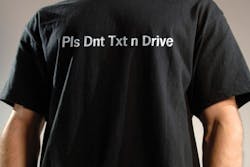Paul Van Aken is a businessman and he wants to make money at his collision repair shop. But he also has a daughter who has a driver’s license and a cell phone. That’s why Van Aken has given away nearly 500 T-shirts he had printed with the message “Pls Dnt Txt n Drive” at six high schools in the area.
“Initially, I planned to spend about $5,000 over 12 months,” says Van Aken, owner of Paul’s Quality Collision in Monroe, Mich. “Now I’m not sure where we’ll end up, because two months in I’ve already spent $4,000.”
Monroe’s daughter reports that kids at her school are wearing the shirts, and Van Aken hopes that means they’re getting the message.
Dangerous times on the road
Last year, nearly 6,000 people died—and 515,000 were injured—in accidents that involved some kind of driver distraction, including cell phone use, according to the Department of Transportation. The National Safety Council estimates that 28 percent of crashes—nearly 1.6 million—involve cell phone use. That’s based on two assumptions, says Dave Teater, NSC director of transportation initiatives.
“One is that the risk of a crash increases fourfold when you’re talking on a cell phone, and numerous studies have documented that,” he says. “The other is a DOT estimate that about 11 percent of people at any given time are on the phone while they’re driving.”
Bob Redding, government affairs representative for the Automotive Service Association, thinks initiatives like Van Aken’s are the best way to curb cell phone use. “Education is always our first choice, and we’ve historically encouraged that before legislation.”
Doing Their Part
King Collision in Plymouth, Mass., is making similar efforts to reduce cell phone use while driving. The shop teamed up with Commerce Insurance Company to put a couple of wrecked cars in front of Plymouth North and Plymouth South, the two high schools in the area. The wrecks draw attention to a campaign that encourages young drivers to sign a contract with their parents that spells out safe driving practices for them to follow. It doesn’t prohibit young drivers from using their phones, but it does have a section for parents to spell out any limitations on cell phone use while driving.
Bruce King, the owner of King Collision, explains that while it would be nice if somebody remembered the shop’s name from the campaign, the purpose is community-minded, not promotional. “It’s an opportunity to give back to the community, because we really don’t want kids getting hurt,” he says.
Van Aken agrees. His shirts don’t have the Paul’s Quality Collision logo, or the logo of an insurance company that expressed interest in partnering with Van Aken if their logo could be added to the design. “It’s deliberate that it’s not commercialized,” he says. “Kids see right through that kind of thing.”



